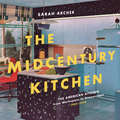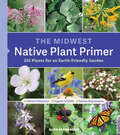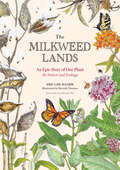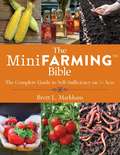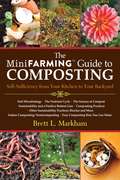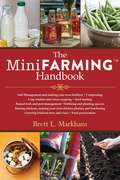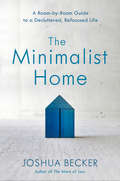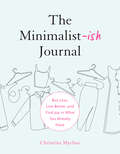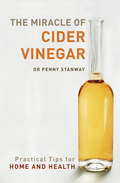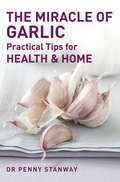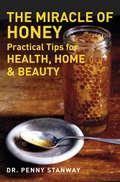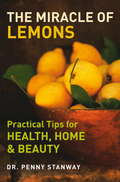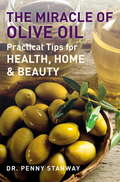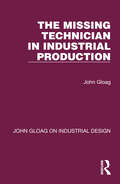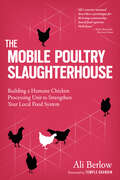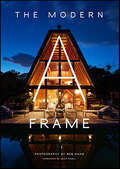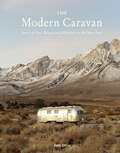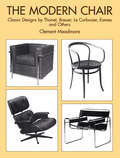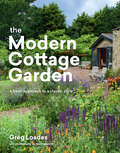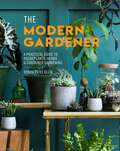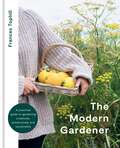- Table View
- List View
The Midcentury Kitchen: America's Favorite Room, From Workspace To Dreamscape, 1940s-1970s
by Sarah ArcherAn illustrated pop history from aqua to avocado, Westinghouse to Wonder Bread Nearly everyone alive today has experienced cozy, welcoming kitchens packed with conveniences that we now take for granted. Sarah Archer, in this delightful romp through a simpler time, shows us how the prosperity of the 1950s kicked off the technological and design ideals of today’s kitchen. In fact, while contemporary appliances might look a little different and work a little better than those of the 1950s, the midcentury kitchen has yet to be improved upon. During the optimistic consumerism of midcentury America when families were ready to put their newfound prosperity on display, companies from General Electric to Pyrex to Betty Crocker were there to usher them into a new era. Counter heights were standardized, appliances were designed in fashionable colors, and convenience foods took over families’ plates. With archival photographs, advertisements, magazine pages, and movie stills, The Midcentury Kitchen captures the spirit of an era—and a room—where anything seemed possible.
The Midwest Native Plant Primer: 225 Plants for an Earth-Friendly Garden
by Alan BranhagenBring Your Garden to Life—and Life to Your Garden! Do you want a garden that makes a real difference? Choose plants native to our Midwest region. The rewards will benefit you, your yard, and the environment—from reducing maintenance tasks to attracting earth-friendly pollinators such as native birds, butterflies, and bees. Native plant expert Alan Branhagen makes adding these superstar plants easier than ever before, with proven advice that every home gardener can follow. This incomparable sourcebook includes 225 recommended native ferns, grasses, wildflowers, perennials, vines, shrubs, and trees. It&’s everything you need to know to create a beautiful and beneficial garden. This must-have handbook is for gardeners in Arkansas, Illinois, Indiana, Iowa, Kansas, Michigan, Minnesota, Missouri, Nebraska, North Dakota, Ohio, South Dakota, and Wisconsin.
The Milkweed Lands: An Epic Story of One Plant: Its Nature and Ecology
by Eric Lee-MäderDelve into this fascinating appreciation of milkweed, an often-overlooked plant, and discover an amazing range of insects and organisms that depend on it as the seasons unfold, with this collaboration between a noted ecologist and an award-winning botanical illustrator. Ecologist Eric Lee-Mäder and noted botanical artist Beverly Duncan have teamed up to create this unique exploration of the complex ecosystem that is supported by the remarkable milkweed plant, often over-looked or dismissed as a roadside weed. With stunning, up-close illustrations and engaging text, they trace every stage of the plant's changes and evolutions throughout the seasons, including germination, growth, flowering, and seed development. Simultaneously, they chronicle the lives of the many creatures whose lives are intertwined with the milkweed: monarch butterflies; soldier and queen butterflies; milkweed tussock moths; large and small milkweed bugs; milkweed weevils; bumble bees; goldfinches; and more. The delightful illustrations and illuminating text give the reader the feeling of browsing an avid naturalist's sketchbook, while also learning about different milkweed species, how to propagate milkweed in the garden, the industrial uses of milkweed, interesting milkweed relatives, and more. This publication conforms to the EPUB Accessibility specification at WCAG 2.0 Level AA.
The Mini Farming Bible: The Complete Guide to Self-Sufficiency on ¼ Acre
by Brett L. MarkhamWhen Brett Markham published a small black and white handbook about how to run a successful mini farm-he never dreamed how popular the book would soon become. In 2010 Skyhorse Publishing Inc. published Brett's book in full color with over a hundred of the author's own photographs-and Mini Farming became an instant bestseller spawning four additional Mini Farming books on everything from fermenting to composting. Now for the first time all 5 Mini Farming titles are collected together in one massive volume:Mini FarmingMaximizing Your Mini FarmMini Farming Guide to CompostingMini Farming Guide to Vegetable GardeningMini Farming Guide to FermentingLearn how to make your own compost, save seeds, start a compost pile, ferment your own wine, get the most out of your vegetable garden-and more! And all on just ¼ acre or less. Learn why tens of thousands of readers across North America have chosen Mini Farming for all their self sufficiency needs. This is the must have guide for any farmer-whether they're beginners or experienced mini farmers looking for new ideas.
The Mini Farming Guide to Composting: Self-Sufficiency from Your Kitchen to Your Backyard
by Brett L. MarkhamComposting has never been easier--learn how to incorporate Brett Markham's amazing composting techniques to maximize your vegetable output, increase your self-sufficiency, and be kind to the ecosystem. Brett Markham, author <
The Mini Farming Handbook
by Brett L. MarkhamBestselling author Brett Markham's new handbook gives us the mini farming basics along with in-depth tips on vegetable gardening, fermenting, composting, and self-sufficiency in a handy new format and design. Includes: Soil management and making your own fertilizer Crop rotation and cover cropping Composting Seed starting and timing/planning Raised beds and pest management Pvc trellising and planting spacers Raising chickens, making your own chicken plucker, and butchering Growing fruit/nut trees and vines Food preservation (canning and freezing) Fermenting wine, vinegar and cheeseWith the full color photographs that made the original Mini Farming so popular, and step by step drawings, projects, graphs, and tables, you'll have everything you need for your new or established mini farm at your fingertips. So dive in a learn how to begin and cultivate your own mini farm on less than a quarter acre.
The Minimalist Home: A Room-by-Room Guide to a Decluttered, Refocused Life
by Joshua BeckerA popular minimalist blogger and author of The More of Less shows you how to methodically turn your home into a place of peace, contentment, and purposeful living.One of today's most influential minimalist advocates takes us on a decluttering tour of our own houses and apartments, showing us how to decide what to get rid of and what to keep. He both offers practical guidelines for simplifying our lifestyle at home and addresses underlying issues that contribute to over-accumulation in the first place. The purpose is not just to create a more inviting living space. It's also to turn our life's HQ--our home--into a launching pad for a more fulfilling and productive life in the world.
The Minimalist-ish Journal: Buy Less, Live Better, and Find Joy in What You Already Have
by Christina MychasThe tool you need to enjoy your life more by buying less—not nothingSo often, happiness seems like it&’s one purchase away. Yet when that trendy jacket or cutting-edge smartphone is in hand and the excitement fades, you&’re back where you started: unsatisfied and unhappy, with a dose of guilt for spending too much money.If you&’re sick of the overconsumption roller coaster, this journal is for you. Full of practical prompts and goal-setting tools, it helps you successfully complete low-buy or no-buy challenges, declutter your physical space, and simplify your life and finances. Using Christina Mychas&’s tried-and-true Minimalist-ish® Method, you&’ll learn to overcome impulse buying, take control of your spending, and truly appreciate what you own—without depriving yourself of comfort or fun. Shift your mindset from one of shame and scarcity to one of intention and abundance with The Minimalist-ish Journal.
The Miracle of Bicarbonate of Soda
by Dr Penny StanwayA brilliant compendium of all the many uses of bicarbonate of soda in the home and for personal care - with practical ways to use it for cooking, cleaning and even health and beauty.
The Miracle of Cider Vinegar
by Dr Penny StanwayA compact yet comprehensive little book that reveals the 'miraculous' properties of cider vinegar - showing that far from being a sort of 'snake oil', it is a valuable natural remedy and household resource.
The Miracle of Garlic
by Dr Penny StanwayThe Miracle of Garlic is a compact yet comprehensive and authoritative guide to garlic, with helpful information on every possible way to use this wonderful product of nature - not only in cooking but also for health and well-being. The book opens with the history of garlic, its importance in the Mediterranean diet and its popularity around the world. The author discusses whether garlic is a miracle medicine, a valuable natural remedy, or just a useful part of a healthy diet. The first part outlines the varieties of garlic and how to grow it. A digest of the contents of garlic and how they affect health is followed by guidance on how to choose, use and store garlic. The second part offers well-tested recipes for well-loved garlic-containing dishes from around the world. The final part offers help on how to use garlic safely to aid health. The A-Z of ailments that can respond to garlic includes the possible causes of each ailment, how garlic can help, and how best to use garlic.
The Miracle of Honey
by Dr Penny StanwayThe Miracle of Honey is a compact yet comprehensive and authoritative guide to honey, with helpful information on every possible way to use this wonderful product of nature - not only in cooking but also for health and well-being. The book opens with the history of honey and its popularity around the world over the millennia. The author discusses whether honey is a miracle medicine, a valuable natural remedy or just a useful part of a healthy diet. The first part of the book outlines the varieties of honey and how they differ. A digest of the contents of honey and how they affect health is followed by guidance on how to choose, use and store honey. The second part offers guidance on making honey-containing beauty products. There is also a comprehensive A-Z of ailments that may benefit from honey, practical instructions on how to use honey or honey-associated products such as beeswax to keep your home sparkling and sweet-smelling, and a variety of recipes for honey-containing dishes. The final section looks at bee-keeping and the vital subject of bee health and survival.
The Miracle of Lemons
by Dr Penny StanwayWith the power to refresh your skin, clean your home and add a touch of magic to your food, lemons truly have 'miraculous' properties and this is a wonderful pocket guide to using them as a powerful natural remedy, reliable beauty aid and useful household resource.
The Miracle of Olive Oil
by Dr Penny StanwayA marvellous practical guide to unlocking the secrets of olive oil, showing how to use it for health, well-being, beauty and cooking - learn why this well-loved 'liquid gold' is such an important part of the life-prolonging "Mediterranean Diet."
The Missing Technician in Industrial Production (John Gloag On Industrial Design Ser.)
by John GloagOriginally published in 1944, The Missing Technician shows how Industrial Design must begin at the very first stages of planning a product. The procedure of a design research committee is outlined – a type of practical co-ordination of the work of industrial designers and production technicians which proved highly effective. The value of materials like aluminium and plastic are emphasized, but equally the importance of glass and cast iron is stressed, especially when handled in new ways that 20th Century techniques made possible.
The Mobile Poultry Slaughterhouse: Building a Humane Chicken-Processing Unit to Strengthen Your Local Food System
by Temple Grandin Ali BerlowIf you’re raising poultry for meat and lack easy access to a humane slaughterhouse, a mobile slaughter and processing unit may be the solution. <P><P>Ali Berlow shows you how to build a unit that accommodates all types of poultry and can easily be moved to any location, making it a great cooperative investment for a community of small-scale farmers. <P><P>Covering the mechanics of construction, sanitation, safety, and permitting processes, this guide shows you how a mobile slaughterhouse can make your poultry operation more self-sufficient.
The Modern A-Frame
by Ben RahnThe A-Frame home surged in popularity in the 1950s, and has captured the public’s imagination with its playfully modern, steep-sloping roofline ever since. The Modern A-Frame celebrates seventeen diverse accounts of these minimalists cabins reinvented for the twenty-first century. Nostalgic escapes, heritage homes, full-time simplicity, and artists at work categorize the A-frames whose engaging stories are shared. Whether fabricated from a 1960s kit or as a new build via retro inspiration, the variety of styles and homeowners in this photo-driven collection beautifully captures the romance of a classic structure, which beckons to travelers and homebuyers today, just as it did sixty years ago. Perfect for the architectural enthusiast, midcentury-minded designer, or armchair traveler.
The Modern Caravan: Stories of Love, Beauty, and Adventure on the Open Road
by Kate OliverA gorgeous book celebrating travel, adventure, and beautifully styled rolling homes.The Modern Caravan is a warm invitation into rolling homes designed for life on the open road.Brimming with evocative storytelling and hundreds of photographs showcasing handsome interiors and stunning landscapes, this book features more than 35 stories from solo travelers, couples, and families who traded the comforts of a rooted life for ever-changing vistas and eye-opening experiences.Readers will meet a family exploring Australia in a cozy vintage camper filled with plants and natural wood finishes; a young couple designing a modern trailer inspired by the colors and textures of the high desert; and a couple who renovated their chic Airstream with green velvet seating, floral wallpaper, and herringbone wood floors.Balancing style with function, each carefully crafted tiny home is the result of long-held dreams, ingenuity, and imagination.EXPERT AUTHOR: Kate Oliver is a celebrated Airstream builder and designer. Her work has been profiled in Dwell, Remodelista, Domino, Apartment Therapy, and Design*Sponge, among others. In this book, she draws on her experience as a designer, builder, storyteller, and photographer to create a one-of-a-kind book full of wanderlust and inspiration—the ultimate guide to beautiful small-space living.SPEAKS TO WANDERLUST TREND: The book speaks to anyone eager for products and experiences that offer an escape into a world of simple pleasures and exploration. With gorgeous travel photography, engaging stories, and practical tips, this package will appeal to design enthusiasts, armchair travelers, and anyone who dreams of a life of adventure.BEAUTIFUL GIFT: This is the perfect gift for anyone who loves road trips, outdoor adventure, or interior design. The book includes hundreds of gorgeous photographs and makes for a thoughtful present to give along with any adventure accessory or decor object—a flannel shirt, a ceramic bowl, or a beautiful blanket—and the eye-catching package will add beauty wherever it's displayed.Perfect for:• People interested in travel and alternative living spaces• Interior designers• Minimalists• Armchair travelers• Weekend adventurers and road trippers• Followers of the #vanlife movement• Fans of Cabin Porn and The New Bohemians
The Modern Chair: Classic Designs by Thonet, Breuer, Le Corbusier, Eames and Others
by Clement MeadmoreMore than 40 "classic" modern chairs, illustrated and discussed by a noted furniture designer, exemplify the marriage of practicality and aesthetics. Thonet's Bentwood armchair, Breuer's Wassily chair, van der Rohe's Barcelona chair, and many others are depicted in photographs and explanatory drawings.
The Modern Cottage Garden: A Fresh Approach to a Classic Style
by Greg Loades&“An inspirational book, with encouraging words and down-to earth advice for achieving a year-round beautiful garden.&” —Michael Marriott, chief rosarian at David Austin Roses In this practical and inspirational guide, Greg Loades presents a new style of planting: a fusion between classic cottage style and the new perennial movement. Using real gardens as examples, The Modern Cottage Garden teaches gardeners how to combine the best of both styles—big, colorful blooms and striking grasses and native plants—into one beautiful space that requires little maintenance and has a long season of interest. Fresh planting ideas for containers, small gardens, and diverse climates present an exciting style that can shine anywhere.
The Modern Gardener: A Practical Guide to Houseplants, Herbs & Container Gardening
by Sonya Patel EllisThis informative guide to selecting, potting, and tending to all types of plants will give your home a trendy, modern appeal.The Modern Gardener will help you give your home a chic, modern aesthetic with the right plants—indoors and out. With sections devoted to choosing the right plants, budgeting, and making the best use of your available space, you&’ll be able to transform your home into a sanctuary for the plants that will give it an appealing vibe. Chapters on tending to all sorts of plants—including annuals, perennials, herbs, flowers, and edibles—make this a handy how-to guide for beginner and experienced gardeners alike. Using a little TLC and the many helpful tips in this book, your home will be blooming with life in no time.
The Modern Gardener: A practical guide to gardening creatively, productively and sustainably
by Frances Tophill'Frances Tophill is not only a qualified horticulturalist but is fast becoming the fresh new face of television gardening.' Daily MailWe no longer just want to garden, we want to engage with the land; the plants in it, the animals, insects and even the fungi. The Modern Gardener isn't just about creating a space that simply looks visually stunning, but about encouraging wildlife, reducing our carbon footprint and making our outdoor and indoor space more useful in all areas of our lives. As well as how to select and grow your plants, there is also information for how to design your garden alongside a variety of plant-based recipes - from delicious drinks to natural dyes - that can easily be made at home.
The Modern Gardener: A practical guide to gardening creatively, productively and sustainably
by Frances Tophill'Frances Tophill is not only a qualified horticulturalist but is fast becoming the fresh new face of television gardening.' Daily MailWe no longer just want to garden, we want to engage with the land; the plants in it, the animals, insects and even the fungi. The Modern Gardener isn't just about creating a space that simply looks visually stunning, but about encouraging wildlife, reducing our carbon footprint and making our outdoor and indoor space more useful in all areas of our lives. As well as how to select and grow your plants, there is also information for how to design your garden alongside a variety of plant-based recipes - from delicious drinks to natural dyes - that can easily be made at home.
The Modern Girl's Guide to Life
by Jane BuckinghamA stylishly smart collection of practical advice for the busy modern woman With information on entertaining, etiquette, housekeeping, basic home repair, decorating, sex, and beauty, this indispensable book has everything today's young woman should know-but may not! The Modern Girl's Guide to Life is a collection of all the helpful tips and secrets that get passed on from generation to generation, but many of us have somehow missed. It's full of practical, definitive advice on the basics -- the day-to-day necessities like finding a bra that fits, balancing a checkbook, making a decent cup of coffee, and hemming a pair of pants. Modern Girl guru Jane Buckingham includes loads of savvy counsel to help us feel more refined, in charge, and together as we navigate the rocky terrain that is twenty-first-century womanhood.
The Modern House Bus: Mobile Tiny House Inspirations
by Kimberley Mok"[A] practical and transporting primer on the…skoolie movement" —Vogue.com For homeowners seeking a simpler life and apartment dwellers dreaming of their own space, tiny houses represent an inspiring, attainable ideal. For those fueled by wanderlust, converted buses—they call them “skoolies”—take the tiny house adventure one step further. Reborn as cozy homes, these retired school buses are ready to hit the road. And unlike the bohemian house buses of 1960s counterculture, many of today’s conversions adhere to a contemporary aesthetic of sleek minimalism. In The Modern House Bus, journalist Kimberley Mok shares 12 buses that are sure to inspire. These are families following a new American dream that values financial freedom over square footage, adventure over manicured lawns. Designed to fit the owner’s lifestyle and needs, the conversions are filled with inventive architectural details, creative materials, and unique style. Filled with photographs of the buses and their breathtaking surroundings and ideas space-saving hacks, this is a book for aspiring bus-owners and armchair adventurers alike.
